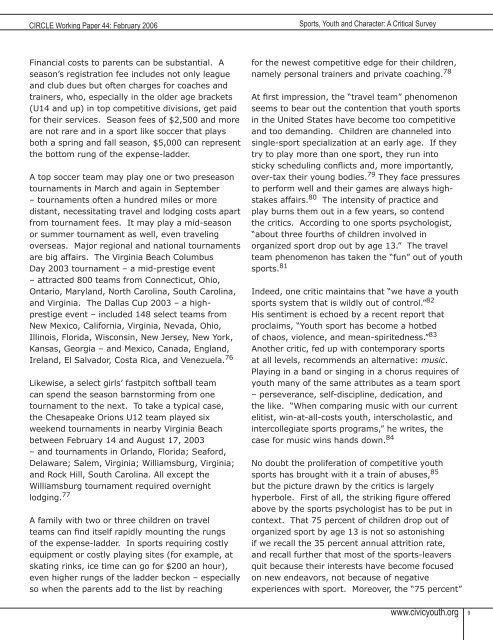The All-Sports Ministry of PA NJ & DE - Executive Summary Start-Up Budget & Prospectus
The All-Sports Ministry of PA NJ & DE - Executive Summary Start-Up Budget & Prospectus
The All-Sports Ministry of PA NJ & DE - Executive Summary Start-Up Budget & Prospectus
Create successful ePaper yourself
Turn your PDF publications into a flip-book with our unique Google optimized e-Paper software.
CIRCLE Working Paper 44: February 2006<br />
<strong>Sports</strong>, Youth and Character: A Critical Survey<br />
Financial costs to parents can be substantial. A<br />
season’s registration fee includes not only league<br />
and club dues but <strong>of</strong>ten charges for coaches and<br />
trainers, who, especially in the older age brackets<br />
(U14 and up) in top competitive divisions, get paid<br />
for their services. Season fees <strong>of</strong> $2,500 and more<br />
are not rare and in a sport like soccer that plays<br />
both a spring and fall season, $5,000 can represent<br />
the bottom rung <strong>of</strong> the expense-ladder.<br />
A top soccer team may play one or two preseason<br />
tournaments in March and again in September<br />
– tournaments <strong>of</strong>ten a hundred miles or more<br />
distant, necessitating travel and lodging costs apart<br />
from tournament fees. It may play a mid-season<br />
or summer tournament as well, even traveling<br />
overseas. Major regional and national tournaments<br />
are big affairs. <strong>The</strong> Virginia Beach Columbus<br />
Day 2003 tournament – a mid-prestige event<br />
– attracted 800 teams from Connecticut, Ohio,<br />
Ontario, Maryland, North Carolina, South Carolina,<br />
and Virginia. <strong>The</strong> Dallas Cup 2003 – a highprestige<br />
event – included 148 select teams from<br />
New Mexico, California, Virginia, Nevada, Ohio,<br />
Illinois, Florida, Wisconsin, New Jersey, New York,<br />
Kansas, Georgia – and Mexico, Canada, England,<br />
Ireland, El Salvador, Costa Rica, and Venezuela. 76<br />
Likewise, a select girls’ fastpitch s<strong>of</strong>tball team<br />
can spend the season barnstorming from one<br />
tournament to the next. To take a typical case,<br />
the Chesapeake Orions U12 team played six<br />
weekend tournaments in nearby Virginia Beach<br />
between February 14 and August 17, 2003<br />
– and tournaments in Orlando, Florida; Seaford,<br />
Delaware; Salem, Virginia; Williamsburg, Virginia;<br />
and Rock Hill, South Carolina. <strong>All</strong> except the<br />
Williamsburg tournament required overnight<br />
lodging. 77<br />
A family with two or three children on travel<br />
teams can find itself rapidly mounting the rungs<br />
<strong>of</strong> the expense-ladder. In sports requiring costly<br />
equipment or costly playing sites (for example, at<br />
skating rinks, ice time can go for $200 an hour),<br />
even higher rungs <strong>of</strong> the ladder beckon – especially<br />
so when the parents add to the list by reaching<br />
for the newest competitive edge for their children,<br />
namely personal trainers and private coaching. 78<br />
At first impression, the “travel team” phenomenon<br />
seems to bear out the contention that youth sports<br />
in the United States have become too competitive<br />
and too demanding. Children are channeled into<br />
single-sport specialization at an early age. If they<br />
try to play more than one sport, they run into<br />
sticky scheduling conflicts and, more importantly,<br />
over-tax their young bodies. 79 <strong>The</strong>y face pressures<br />
to perform well and their games are always highstakes<br />
affairs. 80 <strong>The</strong> intensity <strong>of</strong> practice and<br />
play burns them out in a few years, so contend<br />
the critics. According to one sports psychologist,<br />
“about three fourths <strong>of</strong> children involved in<br />
organized sport drop out by age 13.” <strong>The</strong> travel<br />
team phenomenon has taken the “fun” out <strong>of</strong> youth<br />
sports. 81<br />
Indeed, one critic maintains that “we have a youth<br />
sports system that is wildly out <strong>of</strong> control.” 82<br />
His sentiment is echoed by a recent report that<br />
proclaims, “Youth sport has become a hotbed<br />
<strong>of</strong> chaos, violence, and mean-spiritedness.” 83<br />
Another critic, fed up with contemporary sports<br />
at all levels, recommends an alternative: music.<br />
Playing in a band or singing in a chorus requires <strong>of</strong><br />
youth many <strong>of</strong> the same attributes as a team sport<br />
– perseverance, self-discipline, dedication, and<br />
the like. “When comparing music with our current<br />
elitist, win-at-all-costs youth, interscholastic, and<br />
intercollegiate sports programs,” he writes, the<br />
case for music wins hands down. 84<br />
No doubt the proliferation <strong>of</strong> competitive youth<br />
sports has brought with it a train <strong>of</strong> abuses, 85<br />
but the picture drawn by the critics is largely<br />
hyperbole. First <strong>of</strong> all, the striking figure <strong>of</strong>fered<br />
above by the sports psychologist has to be put in<br />
context. That 75 percent <strong>of</strong> children drop out <strong>of</strong><br />
organized sport by age 13 is not so astonishing<br />
if we recall the 35 percent annual attrition rate,<br />
and recall further that most <strong>of</strong> the sports-leavers<br />
quit because their interests have become focused<br />
on new endeavors, not because <strong>of</strong> negative<br />
experiences with sport. Moreover, the “75 percent”<br />
www.civicyouth.org 9

















